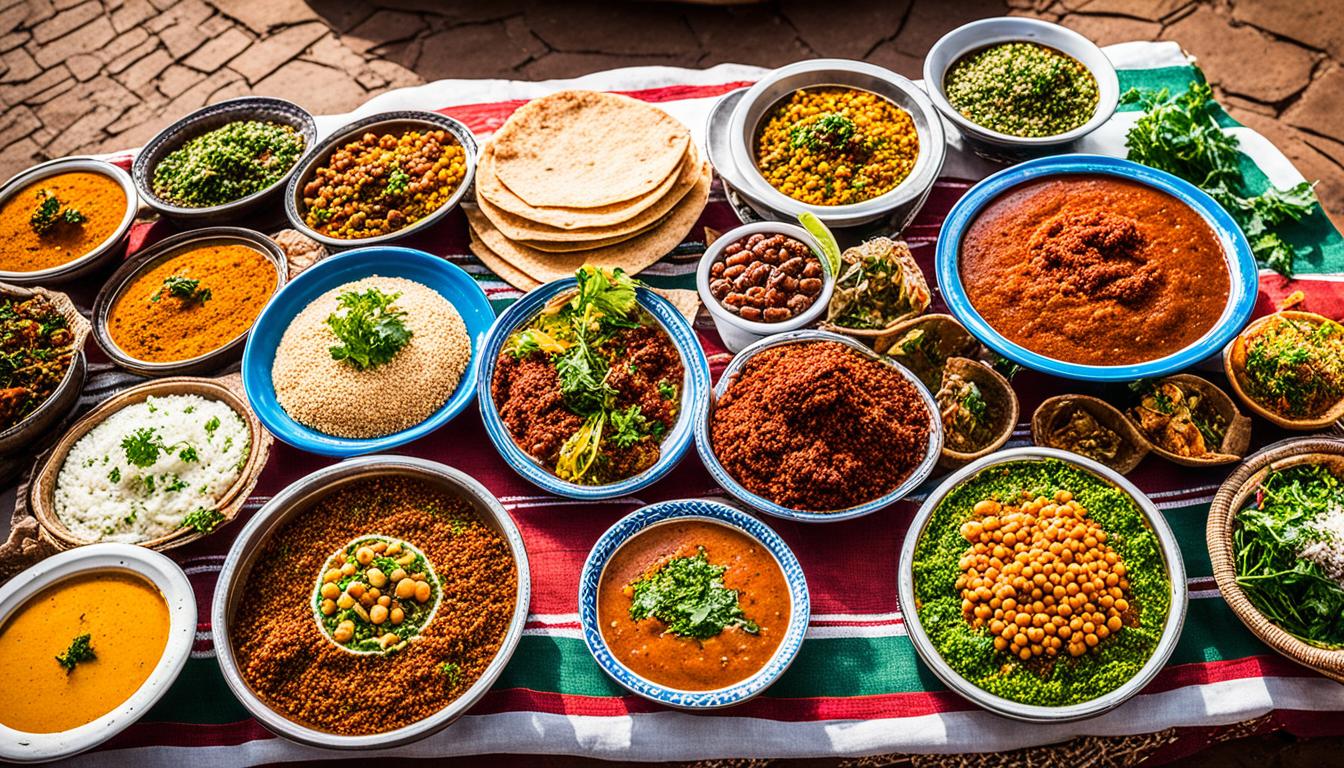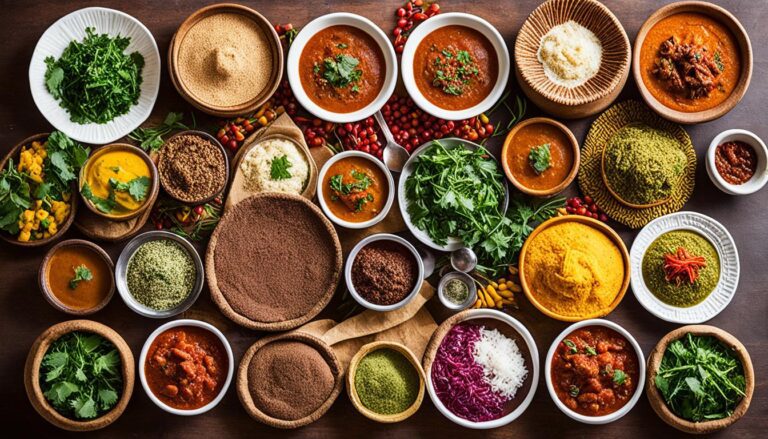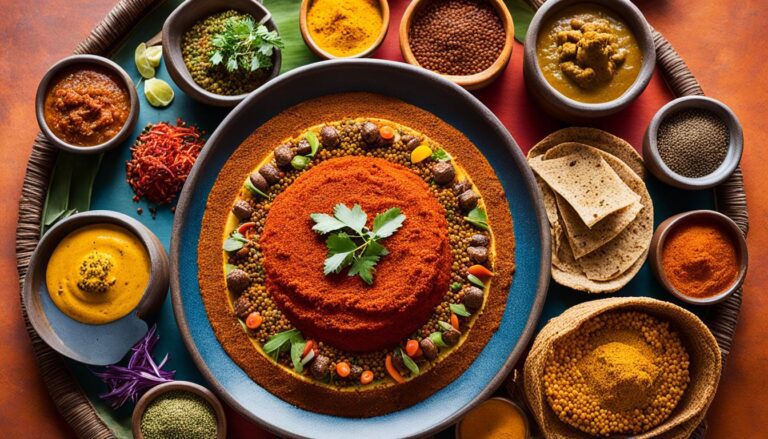What Is Typical Ethiopian Food?
Have you ever wondered what makes Ethiopian food so special? From its vibrant flavors to its communal dining style, Ethiopian cuisine stands out from the crowd. Whether you’re a food enthusiast or simply curious about different culinary traditions, exploring the world of typical Ethiopian food is sure to leave you amazed. So, what exactly sets Ethiopian cuisine apart?
- Typical Ethiopian food is known for its distinctive flavors and vibrant spices.
- Injera, a sourdough-risen flatbread made from teff flour, is the foundation of Ethiopian cuisine.
- Berbere, mitmita, awaze, and niter kibbeh are common spices and ingredients used in Ethiopian cooking.
- Eating Ethiopian food is a communal experience, promoting sharing and connection.
- Ethiopian cuisine offers a wide range of vegetarian and vegan options, making it suitable for different dietary preferences.
The Foundation of Ethiopian Food: Injera
Injera is the heart and soul of Ethiopian cuisine. Made from teff flour, a gluten-free grain native to Ethiopia, injera is a versatile and essential component of Ethiopian meals. This Ethiopian flatbread is more than just bread; it’s a cultural symbol and an integral part of the dining experience.
With its distinct sour taste and spongy texture, injera adds an intriguing flavor profile to any meal. It is traditionally prepared using a sourdough fermentation process, which contributes to its unique taste. The tangy notes of injera perfectly complement the rich flavors of Ethiopian dishes, enhancing the overall dining experience.
Injera serves a dual purpose in Ethiopian cuisine. It is not only a utensil but also a serving plate. Ethiopian dishes, such as stews and curries, are served on a large platter with injera spread across it. The injera acts as a base, soaking up the flavorful juices, and is torn into pieces to scoop up the various dishes. This communal way of sharing food brings people together, fostering a sense of unity and connection.
What makes injera truly unique is its main ingredient, teff flour. Teff is a small, ancient grain that is packed with nutrients. It is rich in fiber, iron, calcium, and magnesium, making it a nutritious choice for those seeking a wholesome meal. Furthermore, teff is naturally gluten-free, making injera a suitable option for individuals with gluten sensitivities or those following a gluten-free diet.
Experience the Essence of Ethiopian Cuisine with Injera
Whether you’re indulging in Doro Wat, a delectable chicken stew, or savoring Misir Wat, a spicy lentil curry, the experience is not complete without injera. Its unique texture, tangy taste, and the ability to bring people together make injera an indispensable part of Ethiopian food culture.
So, the next time you have the opportunity to try Ethiopian cuisine, don’t miss the chance to taste the essence of Ethiopia with injera. Let the flavors of this Ethiopian flatbread transport you to the vibrant streets of Addis Ababa, where injera is savored with every bite.
Flavors and Spices of Ethiopian Food
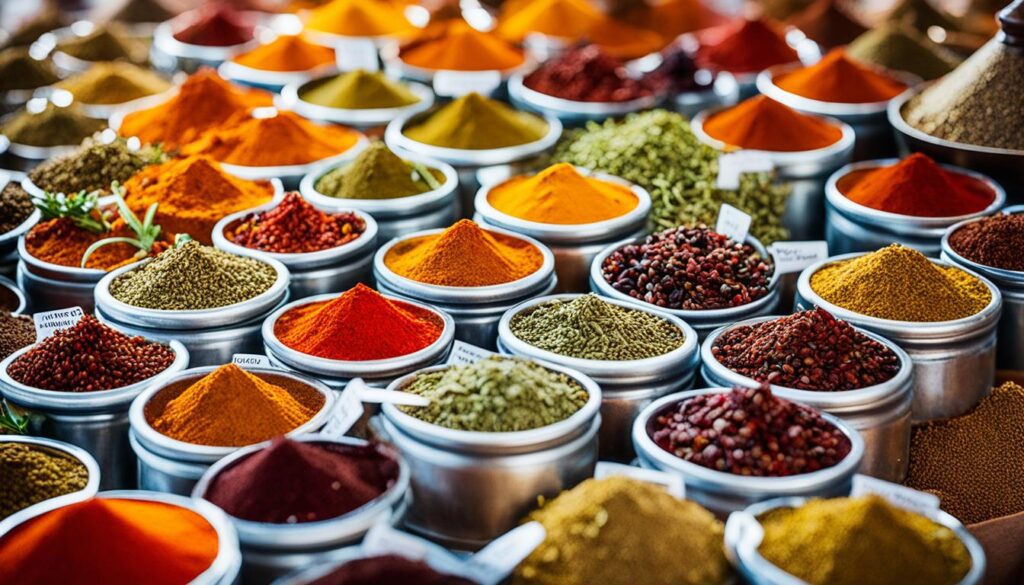
Ethiopian food is well-seasoned with a variety of spices and herbs that add depth and complexity to its dishes. The flavors of Ethiopian cuisine are a true reflection of the country’s rich culinary heritage.
Berbere: Aromatic Spice Blend
One of the most prominent spice blends in Ethiopian cuisine is berbere. It is a fiery blend made from a combination of chili powder, fenugreek, ginger, garlic, and cinnamon. The berbere spice blend adds heat and a burst of flavor to various dishes and is often used to season meats, stews, and lentil dishes.
Mitmita: Bold and Spicy
Mitmita is another popular spice blend that packs a punch. It is known for its intense spiciness and is used to add heat to meat dishes, such as Ethiopian-style grilled meats. The combination of chili peppers, cloves, and spices gives mitmita its unique and vibrant flavor.
Awaze: The Versatile Condiment
Awaze is a versatile condiment made with berbere, oil, and Ethiopian wine or whiskey. It is commonly used as a dipping sauce for various dishes, adding a tangy and spicy kick. Awaze is often enjoyed with injera, the traditional Ethiopian flatbread, or used as a marinade for grilled meats.
Niter Kibbeh: Infused Ethiopian Butter
Niter kibbeh, or Ethiopian butter, is an essential ingredient in Ethiopian cooking. It is made by clarifying butter and infusing it with aromatic spices like cumin, cinnamon, and cardamom. The result is a rich and flavorful butter that elevates the taste of many Ethiopian dishes.
To truly experience the vibrant flavors of Ethiopian cuisine, these spices and condiments are essential. They infuse each dish with a unique taste that is both aromatic and satisfying.
Ethiopian Food and Communal Dining
Eating Ethiopian food is more than just a meal—it’s a communal experience that brings people together. In Ethiopian culture, meals are often served on a large platter called a mesob, and everyone sits around it to share the food. This communal dining style creates a sense of connection and fosters a warm and friendly atmosphere.
One unique Ethiopian tradition that highlights the importance of communal dining is the gursha. This is the act of feeding someone a bite of food, typically using your hand, as a sign of respect or affection. It is a gesture that signifies the bonds of friendship and the joy of sharing food with loved ones.
Sharing food is deeply ingrained in Ethiopian culture, and it extends beyond family and friends. Ethiopians are known for their hospitality and generosity, often sharing meals with guests and strangers alike. It’s a beautiful way to connect with others and experience the true essence of Ethiopian culture.
Embracing togetherness through communal dining
In Ethiopian restaurants, you can enjoy the delightful experience of communal dining. The food is typically served on a large platter covered with injera, the traditional Ethiopian flatbread. The variety of dishes, such as savory stews and flavorful vegetarian options, are placed on top of the injera. Diners then tear off pieces of injera to scoop up the delicious food, creating a flavorful and interactive meal.
Communal dining not only allows you to try a diverse range of flavors but also encourages conversation, laughter, and a sense of unity. It’s the perfect way to bond and create lasting memories with your dining companions.
Vegetarian and Vegan Options in Ethiopian Cuisine
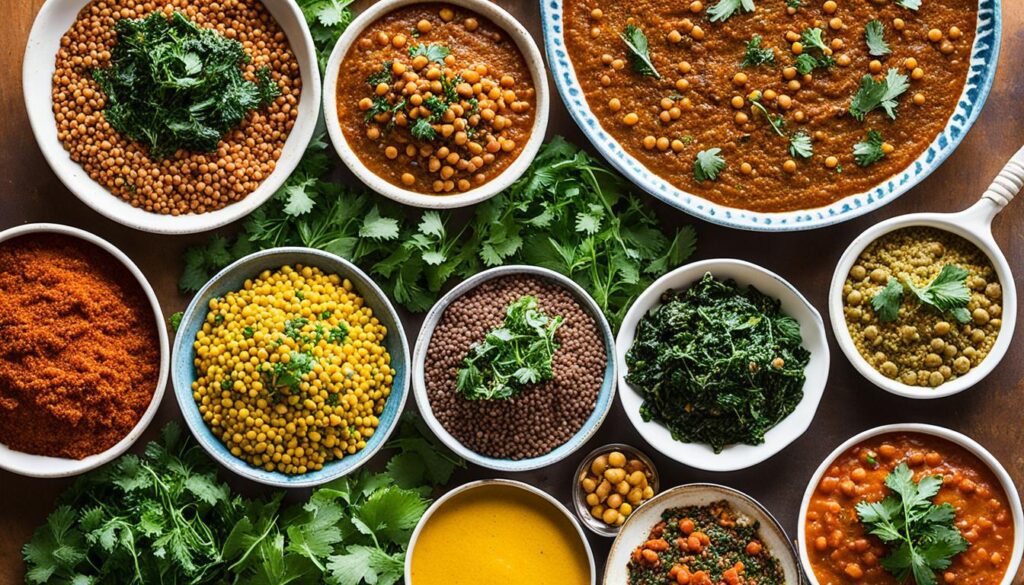
Ethiopian cuisine offers a wide array of delicious options for those following a vegetarian or vegan diet. In fact, vegetarian and vegan food has a strong tradition in Ethiopia, particularly on fasting days when meat and animal products are restricted. This makes Ethiopian cuisine a perfect choice for individuals seeking plant-based meals.
Many Ethiopian dishes are made with lentils, vegetables, and spices, showcasing the country’s culinary creativity in creating flavorful plant-based meals. Lentils, in particular, are a staple in Ethiopian cooking, and dishes like Misir Wot (spicy lentil stew) and Atakilt Wat (spiced cabbage and carrot dish) are popular vegetarian options.
Moreover, Ethiopian spices play a crucial role in enhancing the flavors of vegetarian dishes. The aromatic blend of berbere, a spice mixture typically made with chili powder, fenugreek, ginger, garlic, and cinnamon, adds a unique and vibrant taste to lentil and vegetable-based creations.
For vegans, there are plenty of options to explore as well. In Ethiopian cuisine, vegetable stews, such as Shiro (made from ground chickpeas) and Gomen (collard greens), are often prepared without the use of animal products. Additionally, injera, the traditional Ethiopian flatbread, is typically vegan as it is made from teff flour and water.
Whether you’re a vegetarian, vegan, or simply looking to incorporate more plant-based meals into your diet, Ethiopian cuisine offers a diverse range of options to satisfy your taste buds. The flavorful spices, hearty vegetables, and legumes make for a truly enjoyable dining experience.
Ethiopian Cuisine Goes Global
Ethiopian cuisine has captivated the taste buds of food lovers worldwide, leading to a surge in global popularity. Ethiopian restaurants and dishes have become increasingly prevalent in many cities, showcasing the international reach of this flavorful cuisine.
The unique flavors of Ethiopian food, characterized by aromatic spices and bold seasonings, have turned heads and delighted palates across continents. From the famous berbere spice blend to the tangy injera, each dish tells a story of Ethiopian culinary culture.
But it’s not just the flavors that have caught attention – Ethiopian food offers a communal dining experience that fosters connection and shared enjoyment. The tradition of communal dining in Ethiopian culture enhances the culinary experience, making it more than just a meal but a social event.
As Ethiopian cuisine continues to gain global recognition, its ingredients and cooking techniques have found their way into other cultures. Chefs around the world are incorporating Ethiopian flavors and influences into their own creations, resulting in exciting fusion dishes that bridge culinary traditions.
Globalization has undoubtedly played a role in spreading the love for Ethiopian food. People from all walks of life can now experience the rich and diverse flavors of Ethiopia, adding to the global tapestry of cuisine.
Whether you’re an adventurous foodie exploring new flavors or an Ethiopian expatriate seeking a taste of home, the global popularity of Ethiopian food ensures that you can find a slice of Ethiopia wherever you are.
The Healthy Side of Ethiopian Food
Ethiopian food not only tantalizes your taste buds but also offers a healthy and nutritious dining experience. The cuisine incorporates a variety of ingredients that contribute to overall well-being.
One of the healthful aspects of Ethiopian food lies in its use of high-fiber grains. Teff, a gluten-free grain, is the foundation of Ethiopian flatbread, known as injera. This nutrient-rich grain is packed with fiber, which aids digestion and promotes a healthy gut.
In addition to teff, Ethiopian cuisine includes legumes like chickpeas and lentils. These plant-based proteins are excellent sources of fiber, vitamins, and minerals. The inclusion of legumes in Ethiopian dishes increases their nutritional value and offers a healthier alternative for vegetarians and vegans.
Fermentation is another key aspect of healthy Ethiopian food. Fermented foods such as injera not only add unique flavors but also contribute to gut health. Fermentation breaks down complex carbohydrates, making them easier to digest and enriching the food with beneficial bacteria.
Furthermore, Ethiopian cuisine incorporates various herbs and spices, which not only enhance the flavors but also provide health benefits. Spices like ginger and garlic have anti-inflammatory properties, while cinnamon and fenugreek are known to regulate blood sugar levels. By incorporating these herbs and spices into their dishes, Ethiopians have long enjoyed the health benefits they provide.
Whether you are looking to incorporate high-fiber grains, legumes, or fermented foods into your diet, Ethiopian cuisine offers a delicious and nutritious way to do so. Indulge in the flavors of Ethiopia while enjoying the healthful benefits of its traditional dishes.
Conclusion
Ethiopian food is a culinary journey that tantalizes the taste buds and embraces the senses. With its vibrant flavors, communal dining style, and unique spices, Ethiopian cuisine offers a truly distinctive dining experience.
At the heart of Ethiopian food is the beloved injera, a sourdough flatbread made from teff flour. This versatile bread serves as both a serving plate and an edible utensil, elevating the dining experience to a whole new level.
From the fiery berbere spice blend to the aromatic niter kibbeh, Ethiopian cuisine is a symphony of flavors that will delight both plant-based eaters and meat lovers alike. The rich use of lentils, vegetables, and spices creates a wide range of vegetarian and vegan options that are both delicious and satisfying.
So, whether you’re having a family gathering or just craving an adventure for your taste buds, Ethiopian food will transport you to the bustling streets of Addis Ababa. Come and experience the warmth of Ethiopian hospitality and the mouthwatering dishes that have captured the hearts of food enthusiasts around the globe. Discover the rich flavors and traditions of Ethiopia and embark on a culinary journey like no other.

